Test Bank for Strategic Management: A Competitive Advantage Approach, Concepts, 15/E 15th Edition Fred R. David, Forest R. David
$35.00
ISBN-10: 013382389X
ISBN-13: 9780133823899
For undergraduate and graduate courses in strategy.
In today’s economy, gaining and sustaining a competitive advantage is harder than ever. Strategic Management captures the complexity of the current business environment and delivers the latest skills and concepts with unrivaled clarity, helping students develop their own cutting-edge strategy through skill-developing exercises.
The Fifteenth Edition has been thoroughly updated and revised with current research and concepts. This edition includes 29 new cases and end-of- chapter material, including added exercises and review questions.
- Description
- Reviews (0)
Description
You will receive this product immediate after placing the order
Test Bank for Strategic Management: A Competitive Advantage Approach, Concepts, 15/E, Fred R. David, Forest R. David, ISBN-10: 013382389X , ISBN-13: 9780133823899
This is not a textbook or e-book version of the original text. Its called TEST BANK contains Multiple Choice Questions with Answers. All chapter’s Tests are available. Buyer will receive the download (File type: pdf/word/exl..etc) in his email as soon as transaction completed. Please download sample for your confidential.
Table of Contents
I. Overview of Strategic Management
1. The Nature of Strategic Management
THE COHESION CASE: PEPSICO, INC. – 2013
II. Strategy Formulation
2. The Business Vision and Mission
3. The External Assessment
4. The Internal Assessment
5. Strategies in Action
6. Strategy Analysis and Choice
III. Strategy Implementation
7. Implementing Strategies: Management and Operations Issues
8. Implementing Strategies: Marketing, Finance/Accounting, R&D, and MIS Issues
IV. Strategy Evaluation
9. Strategy Review, Evaluation, and Control
V. Key Strategic-Management Topics
10. Business Ethics/Social Responsibility/Environmental Sustainability
11. Global/International Issues
VI. Strategic-Management Case Analysis
How to Prepare and Present a Case Analysis
Name Index
Subject Index
Chapter 6 Strategy Analysis and Choice
1) An organization’s present strategies, objectives and mission, coupled with the external and internal audit information, provide a basis for generating and evaluating feasible alternative strategies.
Answer: TRUE
Diff: 1
Objective: 6.01 Describe a three-stage framework for choosing among alternative strategies.
Learning Outcome: Define corporate strategy and identify its key elements
2) Alternative strategies don’t come out of the blue; they are derived from the firm’s vision, mission, and objectives.
Answer: TRUE
Diff: 2
Objective: 6.01 Describe a three-stage framework for choosing among alternative strategies.
Learning Outcome: Discuss the functions of vision statements, mission statements, and long-term corporate objectives
3) It is vital that strategists always consider all feasible alternatives that could benefit the firm.
Answer: FALSE
Diff: 2
Objective: 6.01 Describe a three-stage framework for choosing among alternative strategies.
Learning Outcome: Define corporate strategy and identify its key elements
4) The first stage of the strategy-formulation framework is the input stage, and it is directly followed by the decision stage.
Answer: FALSE
Diff: 1
Objective: 6.01 Describe a three-stage framework for choosing among alternative strategies.
Learning Outcome: Define corporate strategy and identify its key elements
5) Stage 2 in the strategy-formulation framework involves the Quantitative Strategic Planning Matrix.
Answer: FALSE
Diff: 2
Objective: 6.01 Describe a three-stage framework for choosing among alternative strategies.
Learning Outcome: Define corporate strategy and identify its key elements
6) The Strengths-Weaknesses-Opportunities-Threats (SWOT) Matrix, the Strategic Position and Action Evaluation (SPACE) Matrix, the Boston Consulting Group (BCG) Matrix, the Internal-External (IE) Matrix, and the Grand Strategy Matrix are included in stage two of the strategy-formulation framework.
Answer: TRUE
Diff: 3
Objective: 6.01 Describe a three-stage framework for choosing among alternative strategies.
Learning Outcome: Define corporate strategy and identify its key elements
7) Good intuitive judgment is always needed to determine appropriate weights and ratings in the input stage matrices.
Answer: TRUE
Diff: 2
Objective: 6.04 Discuss the role of intuition in strategic analysis and choice.
Learning Outcome: Define corporate strategy and identify its key elements
8) When completing the matching stage of the strategy-formulation framework, the SWOT Matrix needs to be completed before the SPACE Matrix.
Answer: FALSE
Diff: 3
AACSB: Analytical Thinking
Objective: 6.01 Describe a three-stage framework for choosing among alternative strategies.
Learning Outcome: Define corporate strategy and identify its key elements
9) The purpose of matching key factors is to generate feasible alternative strategies.
Answer: TRUE
Diff: 1
Objective: 6.01 Describe a three-stage framework for choosing among alternative strategies.
Learning Outcome: Define corporate strategy and identify its key elements
10) Strengths-opportunities strategies are based on using a firm’s internal strengths to take advantage of external opportunities.
Answer: TRUE
Diff: 2
Objective: 6.02 Explain how to develop a Strengths-Weaknesses-Opportunities-Threats (SWOT) Matrix, Strategic Position and Action Evaluation (SPACE) Matrix, Boston Consulting Group (BCG) Matrix, Internal-External (IE) Matrix, and Quantitative Strategic Planning Matrix (QSPM).
Learning Outcome: Define corporate strategy and identify its key elements
11) A SWOT Matrix is composed of four cells for the four types of strategies it creates.
Answer: FALSE
Diff: 1
Objective: 6.02 Explain how to develop a Strengths-Weaknesses-Opportunities-Threats (SWOT) Matrix, Strategic Position and Action Evaluation (SPACE) Matrix, Boston Consulting Group (BCG) Matrix, Internal-External (IE) Matrix, and Quantitative Strategic Planning Matrix (QSPM).
Learning Outcome: Define corporate strategy and identify its key elements
12) One of the steps of the SWOT Matrix is to list the firm’s key external opportunities.
Answer: TRUE
Diff: 1
Objective: 6.02 Explain how to develop a Strengths-Weaknesses-Opportunities-Threats (SWOT) Matrix, Strategic Position and Action Evaluation (SPACE) Matrix, Boston Consulting Group (BCG) Matrix, Internal-External (IE) Matrix, and Quantitative Strategic Planning Matrix (QSPM).
Learning Outcome: Define corporate strategy and identify its key elements
13) The SWOT matrix, if used appropriately, does not have any limitations.
Answer: FALSE
Diff: 2
Objective: 6.02 Explain how to develop a Strengths-Weaknesses-Opportunities-Threats (SWOT) Matrix, Strategic Position and Action Evaluation (SPACE) Matrix, Boston Consulting Group (BCG) Matrix, Internal-External (IE) Matrix, and Quantitative Strategic Planning Matrix (QSPM).
Learning Outcome: Define corporate strategy and identify its key elements
14) The most important determinants of an organization’s overall strategic position are considered to be the two internal dimensions, financial position (FP) and competitive position (CP), and the two external dimensions, industry position (IP) and stability position (SP).
Answer: TRUE
Diff: 3
Objective: 6.02 Explain how to develop a Strengths-Weaknesses-Opportunities-Threats (SWOT) Matrix, Strategic Position and Action Evaluation (SPACE) Matrix, Boston Consulting Group (BCG) Matrix, Internal-External (IE) Matrix, and Quantitative Strategic Planning Matrix (QSPM).
Learning Outcome: Define corporate strategy and identify its key elements
15) The four strategies of the SPACE Matrix are aggressive, conservative, offensive and defensive.
Answer: FALSE
Diff: 2
Objective: 6.02 Explain how to develop a Strengths-Weaknesses-Opportunities-Threats (SWOT) Matrix, Strategic Position and Action Evaluation (SPACE) Matrix, Boston Consulting Group (BCG) Matrix, Internal-External (IE) Matrix, and Quantitative Strategic Planning Matrix (QSPM).
Learning Outcome: Define corporate strategy and identify its key elements
16) Market penetration can be classified as either a conservative, aggressive, or competitive strategy.
Answer: TRUE
Diff: 1
Objective: 6.02 Explain how to develop a Strengths-Weaknesses-Opportunities-Threats (SWOT) Matrix, Strategic Position and Action Evaluation (SPACE) Matrix, Boston Consulting Group (BCG) Matrix, Internal-External (IE) Matrix, and Quantitative Strategic Planning Matrix (QSPM).
Learning Outcome: Define corporate strategy and identify its key elements
17) The SP and CP dimension variables in a SPACE Matrix are assigned a numerical value ranging from -1 (best) to -7 (worst).
Answer: TRUE
Diff: 2
Objective: 6.02 Explain how to develop a Strengths-Weaknesses-Opportunities-Threats (SWOT) Matrix, Strategic Position and Action Evaluation (SPACE) Matrix, Boston Consulting Group (BCG) Matrix, Internal-External (IE) Matrix, and Quantitative Strategic Planning Matrix (QSPM).
Learning Outcome: Define corporate strategy and identify its key elements
18) Conservative strategies in a SPACE Matrix most often include product development, market development, market penetration, and related diversification.
Answer: TRUE
Diff: 2
AACSB: Analytical Thinking
Objective: 6.02 Explain how to develop a Strengths-Weaknesses-Opportunities-Threats (SWOT) Matrix, Strategic Position and Action Evaluation (SPACE) Matrix, Boston Consulting Group (BCG) Matrix, Internal-External (IE) Matrix, and Quantitative Strategic Planning Matrix (QSPM).
Learning Outcome: Define corporate strategy and identify its key elements
19) The firm should pursue conservative strategies if the coordinates of a SPACE directional vector are (-1, +4).
Answer: TRUE
Diff: 3
AACSB: Analytical Thinking
Objective: 6.02 Explain how to develop a Strengths-Weaknesses-Opportunities-Threats (SWOT) Matrix, Strategic Position and Action Evaluation (SPACE) Matrix, Boston Consulting Group (BCG) Matrix, Internal-External (IE) Matrix, and Quantitative Strategic Planning Matrix (QSPM).
Learning Outcome: Define corporate strategy and identify its key elements
20) A firm should pursue defensive strategies if the coordinates of a SPACE directional vector are (+2, +3).
Answer: FALSE
Diff: 2
AACSB: Analytical Thinking
Objective: 6.02 Explain how to develop a Strengths-Weaknesses-Opportunities-Threats (SWOT) Matrix, Strategic Position and Action Evaluation (SPACE) Matrix, Boston Consulting Group (BCG) Matrix, Internal-External (IE) Matrix, and Quantitative Strategic Planning Matrix (QSPM).
Learning Outcome: Define corporate strategy and identify its key elements
21) The firm should pursue aggressive strategies if the coordinates of a SPACE directional vector are (+5, +4).
Answer: TRUE
Diff: 2
AACSB: Analytical Thinking
Objective: 6.02 Explain how to develop a Strengths-Weaknesses-Opportunities-Threats (SWOT) Matrix, Strategic Position and Action Evaluation (SPACE) Matrix, Boston Consulting Group (BCG) Matrix, Internal-External (IE) Matrix, and Quantitative Strategic Planning Matrix (QSPM).
Learning Outcome: Define corporate strategy and identify its key elements
22) Relative market share position is given on the x-axis of the BCG Matrix.
Answer: TRUE
Diff: 2
Objective: 6.02 Explain how to develop a Strengths-Weaknesses-Opportunities-Threats (SWOT) Matrix, Strategic Position and Action Evaluation (SPACE) Matrix, Boston Consulting Group (BCG) Matrix, Internal-External (IE) Matrix, and Quantitative Strategic Planning Matrix (QSPM).
Learning Outcome: Define strategic management and identify its basic concepts
23) The midpoint on the x-axis of a BCG Matrix is typically set at 0.05.
Answer: FALSE
Diff: 2
Objective: 6.02 Explain how to develop a Strengths-Weaknesses-Opportunities-Threats (SWOT) Matrix, Strategic Position and Action Evaluation (SPACE) Matrix, Boston Consulting Group (BCG) Matrix, Internal-External (IE) Matrix, and Quantitative Strategic Planning Matrix (QSPM).
Learning Outcome: Define corporate strategy and identify its key elements
24) The size of the circle in a BCG Matrix corresponds to the proportion of corporate revenue generated by that business unit.
Answer: TRUE
Diff: 2
Objective: 6.02 Explain how to develop a Strengths-Weaknesses-Opportunities-Threats (SWOT) Matrix, Strategic Position and Action Evaluation (SPACE) Matrix, Boston Consulting Group (BCG) Matrix, Internal-External (IE) Matrix, and Quantitative Strategic Planning Matrix (QSPM).
Learning Outcome: Define corporate strategy and identify its key elements
25) In a BCG Matrix the pie slice indicates the proportion of corporate profits generated by that division.
Answer: TRUE
Diff: 1
Objective: 6.02 Explain how to develop a Strengths-Weaknesses-Opportunities-Threats (SWOT) Matrix, Strategic Position and Action Evaluation (SPACE) Matrix, Boston Consulting Group (BCG) Matrix, Internal-External (IE) Matrix, and Quantitative Strategic Planning Matrix (QSPM).
Learning Outcome: Define corporate strategy and identify its key elements
26) Stars, Question Marks, Cash Cows, and Dogs are the four quadrants exhibited by the BCG Matrix.
Answer: TRUE
Diff: 1
Objective: 6.02 Explain how to develop a Strengths-Weaknesses-Opportunities-Threats (SWOT) Matrix, Strategic Position and Action Evaluation (SPACE) Matrix, Boston Consulting Group (BCG) Matrix, Internal-External (IE) Matrix, and Quantitative Strategic Planning Matrix (QSPM).
Learning Outcome: Define corporate strategy and identify its key elements
27) Cash Cows represent the organization’s best long-run opportunities for growth and profitability.
Answer: FALSE
Diff: 2
Objective: 6.02 Explain how to develop a Strengths-Weaknesses-Opportunities-Threats (SWOT) Matrix, Strategic Position and Action Evaluation (SPACE) Matrix, Boston Consulting Group (BCG) Matrix, Internal-External (IE) Matrix, and Quantitative Strategic Planning Matrix (QSPM).
Learning Outcome: Define corporate strategy and identify its key elements
28) The major benefit of the BCG Matrix is that it draws attention to the cash flow, investment characteristics, and needs of an organization’s various divisions.
Answer: TRUE
Diff: 2
Objective: 6.02 Explain how to develop a Strengths-Weaknesses-Opportunities-Threats (SWOT) Matrix, Strategic Position and Action Evaluation (SPACE) Matrix, Boston Consulting Group (BCG) Matrix, Internal-External (IE) Matrix, and Quantitative Strategic Planning Matrix (QSPM).
Learning Outcome: Define corporate strategy and identify its key elements
29) Viewing every business as either a Star, Cash Cow, Dog, or Question Mark is an oversimplification.
Answer: TRUE
Diff: 1
Objective: 6.02 Explain how to develop a Strengths-Weaknesses-Opportunities-Threats (SWOT) Matrix, Strategic Position and Action Evaluation (SPACE) Matrix, Boston Consulting Group (BCG) Matrix, Internal-External (IE) Matrix, and Quantitative Strategic Planning Matrix (QSPM).
Learning Outcome: Define corporate strategy and identify its key elements
30) The BCG Matrix does not reflect whether or not various divisions or their industries are growing over time.
Answer: TRUE
Diff: 2
Objective: 6.02 Explain how to develop a Strengths-Weaknesses-Opportunities-Threats (SWOT) Matrix, Strategic Position and Action Evaluation (SPACE) Matrix, Boston Consulting Group (BCG) Matrix, Internal-External (IE) Matrix, and Quantitative Strategic Planning Matrix (QSPM).
Learning Outcome: Define corporate strategy and identify its key elements
31) Having no temporal qualities, the BCG Matrix is a snapshot of an organization at a given point in time.
Answer: TRUE
Diff: 2
Objective: 6.02 Explain how to develop a Strengths-Weaknesses-Opportunities-Threats (SWOT) Matrix, Strategic Position and Action Evaluation (SPACE) Matrix, Boston Consulting Group (BCG) Matrix, Internal-External (IE) Matrix, and Quantitative Strategic Planning Matrix (QSPM).
Learning Outcome: Define corporate strategy and identify its key elements
32) Both IE and BCG Matrices are called portfolio matrices.
Answer: TRUE
Diff: 2
Objective: 6.02 Explain how to develop a Strengths-Weaknesses-Opportunities-Threats (SWOT) Matrix, Strategic Position and Action Evaluation (SPACE) Matrix, Boston Consulting Group (BCG) Matrix, Internal-External (IE) Matrix, and Quantitative Strategic Planning Matrix (QSPM).
Learning Outcome: Define corporate strategy and identify its key elements
33) The BCG Matrix requires more information about the divisions than the IE Matrix.
Answer: FALSE
Diff: 2
Objective: 6.02 Explain how to develop a Strengths-Weaknesses-Opportunities-Threats (SWOT) Matrix, Strategic Position and Action Evaluation (SPACE) Matrix, Boston Consulting Group (BCG) Matrix, Internal-External (IE) Matrix, and Quantitative Strategic Planning Matrix (QSPM).
Learning Outcome: Define corporate strategy and identify its key elements
34) On the x-axis of the IE Matrix, an IFE total weighted score of 2.5 represents a weak internal position.
Answer: FALSE
Diff: 2
AACSB: Analytical Thinking
Objective: 6.02 Explain how to develop a Strengths-Weaknesses-Opportunities-Threats (SWOT) Matrix, Strategic Position and Action Evaluation (SPACE) Matrix, Boston Consulting Group (BCG) Matrix, Internal-External (IE) Matrix, and Quantitative Strategic Planning Matrix (QSPM).
Learning Outcome: Define corporate strategy and identify its key elements
35) The IE Matrix can be divided into three major regions that have different strategy implications: grow and build, hold and maintain, and harvest or divest.
Answer: TRUE
Diff: 2
Objective: 6.02 Explain how to develop a Strengths-Weaknesses-Opportunities-Threats (SWOT) Matrix, Strategic Position and Action Evaluation (SPACE) Matrix, Boston Consulting Group (BCG) Matrix, Internal-External (IE) Matrix, and Quantitative Strategic Planning Matrix (QSPM).
Learning Outcome: Define corporate strategy and identify its key elements
36) The Grand Strategy Matrix is based on two evaluative dimensions, market share and market growth.
Answer: FALSE
Diff: 2
Objective: 6.02 Explain how to develop a Strengths-Weaknesses-Opportunities-Threats (SWOT) Matrix, Strategic Position and Action Evaluation (SPACE) Matrix, Boston Consulting Group (BCG) Matrix, Internal-External (IE) Matrix, and Quantitative Strategic Planning Matrix (QSPM).
Learning Outcome: Define corporate strategy and identify its key elements
37) According to the Grand Strategy Matrix, when a Quadrant I firm is too heavily committed to a single product, then related diversification may reduce the risks associated with a narrow product line.
Answer: TRUE
Diff: 2
AACSB: Analytical Thinking
Objective: 6.02 Explain how to develop a Strengths-Weaknesses-Opportunities-Threats (SWOT) Matrix, Strategic Position and Action Evaluation (SPACE) Matrix, Boston Consulting Group (BCG) Matrix, Internal-External (IE) Matrix, and Quantitative Strategic Planning Matrix (QSPM).
Learning Outcome: Define corporate strategy and identify its key elements
38) According to the Grand Strategy Matrix, Quadrant III organizations compete in rapid-growth industries and have strong competitive positions.
Answer: FALSE
Diff: 3
Objective: 6.02 Explain how to develop a Strengths-Weaknesses-Opportunities-Threats (SWOT) Matrix, Strategic Position and Action Evaluation (SPACE) Matrix, Boston Consulting Group (BCG) Matrix, Internal-External (IE) Matrix, and Quantitative Strategic Planning Matrix (QSPM).
Learning Outcome: Define corporate strategy and identify its key elements
39) To objectively evaluate feasible alternative strategies identified in Stage 2, the QSPM uses input information derived from Stage 1.
Answer: TRUE
Diff: 2
Objective: 6.02 Explain how to develop a Strengths-Weaknesses-Opportunities-Threats (SWOT) Matrix, Strategic Position and Action Evaluation (SPACE) Matrix, Boston Consulting Group (BCG) Matrix, Internal-External (IE) Matrix, and Quantitative Strategic Planning Matrix (QSPM).
Learning Outcome: Define corporate strategy and identify its key elements
40) Step 1 of a QSPM assigns weights to each key external and internal factor.
Answer: FALSE
Diff: 1
Objective: 6.02 Explain how to develop a Strengths-Weaknesses-Opportunities-Threats (SWOT) Matrix, Strategic Position and Action Evaluation (SPACE) Matrix, Boston Consulting Group (BCG) Matrix, Internal-External (IE) Matrix, and Quantitative Strategic Planning Matrix (QSPM).
Learning Outcome: Define corporate strategy and identify its key elements
41) Total attractiveness scores are defined as the sum of the attractiveness scores in a given column of the QSPM and are computed in the second step of the QSPM.
Answer: FALSE
Diff: 3
Objective: 6.02 Explain how to develop a Strengths-Weaknesses-Opportunities-Threats (SWOT) Matrix, Strategic Position and Action Evaluation (SPACE) Matrix, Boston Consulting Group (BCG) Matrix, Internal-External (IE) Matrix, and Quantitative Strategic Planning Matrix (QSPM).
Learning Outcome: Define corporate strategy and identify its key elements
42) A positive feature of QSPM is that sets of strategies can be examined sequentially or simultaneously.
Answer: TRUE
Diff: 1
Objective: 6.02 Explain how to develop a Strengths-Weaknesses-Opportunities-Threats (SWOT) Matrix, Strategic Position and Action Evaluation (SPACE) Matrix, Boston Consulting Group (BCG) Matrix, Internal-External (IE) Matrix, and Quantitative Strategic Planning Matrix (QSPM).
Learning Outcome: Define corporate strategy and identify its key elements
43) One positive feature of QSPM is that it does not require intuitive judgments and educated assumptions.
Answer: FALSE
Diff: 2
Objective: 6.04 Discuss the role of intuition in strategic analysis and choice.
Learning Outcome: Define corporate strategy and identify its key elements
44) Culture includes the set of shared values, beliefs, attitudes, customs, norms, personalities, heroes, and heroines that describe a firm.
Answer: TRUE
Diff: 2
AACSB: Interpersonal relations and teamwork
Objective: 6.05 Discuss the role of organizational culture in strategic analysis and choice.
Learning Outcome: Define corporate strategy and identify its key elements
45) Strategy changes may be highly effective and productive if a supportive culture does not exist.
Answer: FALSE
Diff: 3
AACSB: Interpersonal relations and teamwork
Objective: 6.05 Discuss the role of organizational culture in strategic analysis and choice.
Learning Outcome: Define corporate strategy and identify its key elements
46) Whenever two firms merge, it becomes especially important to evaluate and consider culture-strategies linkages.
Answer: TRUE
Diff: 1
AACSB: Interpersonal relations and teamwork
Objective: 6.05 Discuss the role of organizational culture in strategic analysis and choice.
Learning Outcome: Define corporate strategy and identify its key elements
47) Successful strategists minimize their own political exposure on issues that are highly controversial and in circumstances where opposition from major power centers is likely.
Answer: TRUE
Diff: 1
Objective: 6.05 Discuss the role of organizational culture in strategic analysis and choice.
Learning Outcome: Define corporate strategy and identify its key elements
48) Trying to achieve optimal results with an unpopular strategy is always better than achieving satisfactory results with a popular strategy.
Answer: FALSE
Diff: 2
Objective: 6.03 Identify important behavioral, political, ethical, and social responsibility considerations in strategy analysis and choice.
Learning Outcome: Define corporate strategy and identify its key elements
49) Shifting focus from specific issues to more general ones may increase strategists’ options for gaining organizational commitment.
Answer: TRUE
Diff: 1
Objective: 6.03 Identify important behavioral, political, ethical, and social responsibility considerations in strategy analysis and choice.
Learning Outcome: Define corporate strategy and identify its key elements
50) The trend in the U.S. is toward larger boards, with an average of 18 members being the norm.
Answer: FALSE
Diff: 2
Objective: 6.06 Discuss the role of a board of directors in choosing among alternative strategies.
Learning Outcome: Describe modern corporate governance practices
51) Today boards of directors are composed mostly of outsiders who are becoming more involved in an organization’s strategic management.
Answer: TRUE
Diff: 2
Objective: 6.06 Discuss the role of a board of directors in choosing among alternative strategies.
Learning Outcome: Describe modern corporate governance practices
52) The Sarbanes-Oxley Act put an end to the “country-club” atmosphere of most boards and has shifted power from CEOs to directors.
Answer: TRUE
Diff: 2
Objective: 6.06 Discuss the role of a board of directors in choosing among alternative strategies.
Learning Outcome: Describe modern corporate governance practices
53) Strategy analysis and choice largely involves making ________ decisions based on ________ information.
- A) long-term; short-term
- B) subjective; objective
- C) short-term; long-term
- D) subjective; short-term
- E) objective; subjective
Answer: B
Diff: 1
Objective: 6.01 Describe a three-stage framework for choosing among alternative strategies.
Learning Outcome: Define corporate strategy and identify its key elements
54) Which stage in the strategy-formulation framework focuses on generating feasible alternative strategies?
- A) Input
- B) Output
- C) Decision
- D) Throughput
- E) Matching
Answer: E
Diff: 2
Objective: 6.01 Describe a three-stage framework for choosing among alternative strategies.
Learning Outcome: Define corporate strategy and identify its key elements
55) Which stage of the strategy-formulation framework involves the Quantitative Strategic Planning Matrix?
- A) Stage 1
- B) Stage 2
- C) Stage 3
- D) Stage 4
- E) Stage 5
Answer: C
Diff: 2
Objective: 6.01 Describe a three-stage framework for choosing among alternative strategies.
Learning Outcome: Define corporate strategy and identify its key elements
56) Which strategy-formulation technique reveals the relative attractiveness of alternative strategies and thus provides an objective basis for selecting specific strategies?
- A) SWOT
- B) SPACE
- C) QSPM
- D) IFE
- E) CPM
Answer: C
Diff: 2
Objective: 6.01 Describe a three-stage framework for choosing among alternative strategies.
Learning Outcome: Define corporate strategy and identify its key elements
57) Each of the nine techniques included in the strategy formulation framework rely on the use of
- A) strictly factual data.
- B) luck.
- C) financial formulas and statistics.
- D) intuition and analysis.
- E) synergy.
Answer: D
Diff: 3
Objective: 6.04 Discuss the role of intuition in strategic analysis and choice.
Learning Outcome: Define corporate strategy and identify its key elements
58) Which stage of the strategy-formulation framework includes an IFE Matrix and a Competitive Profile Matrix?
- A) Input
- B) Matching
- C) Decision
- D) Penetration
- E) Research
Answer: A
Diff: 1
Objective: 6.01 Describe a three-stage framework for choosing among alternative strategies.
Learning Outcome: Compare and contrast different business-level strategies
59) Which stage of the strategy-formulation framework contains the IFE Matrix?
- A) Input stage
- B) Analysis stage
- C) Matching stage
- D) Decision stage
- E) Output stage
Answer: A
Diff: 1
Objective: 6.01 Describe a three-stage framework for choosing among alternative strategies.
Learning Outcome: Define corporate strategy and identify its key elements
60) The match an organization makes between its internal resources and skills and the opportunities and risks created by its external factors can be defined as
- A) input.
- B) concept formulation.
- C) strategy.
- D) SWOT.
- E) weakness.
Answer: C
Diff: 2
Objective: 6.01 Describe a three-stage framework for choosing among alternative strategies.
Learning Outcome: Define corporate strategy and identify its key elements
61) Which section of the SWOT Matrix involves matching internal strengths with external opportunities?
- A) The WT cell
- B) The SW cell
- C) The WO cell
- D) The ST cell
- E) The SO cell
Answer: E
Diff: 3
Objective: 6.02 Explain how to develop a Strengths-Weaknesses-Opportunities-Threats (SWOT) Matrix, Strategic Position and Action Evaluation (SPACE) Matrix, Boston Consulting Group (BCG) Matrix, Internal-External (IE) Matrix, and Quantitative Strategic Planning Matrix (QSPM).
Learning Outcome: Define corporate strategy and identify its key elements
62) Which strategies aim at improving internal weaknesses by taking advantage of external opportunities?
- A) SO
- B) WO
- C) SW
- D) ST
- E) WT
Answer: B
Diff: 2
Objective: 6.02 Explain how to develop a Strengths-Weaknesses-Opportunities-Threats (SWOT) Matrix, Strategic Position and Action Evaluation (SPACE) Matrix, Boston Consulting Group (BCG) Matrix, Internal-External (IE) Matrix, and Quantitative Strategic Planning Matrix (QSPM).
Learning Outcome: Define corporate strategy and identify its key elements
63) Which strategies use a firm’s strengths to avoid or reduce the impact of external threats?
- A) SO
- B) WO
- C) SW
- D) ST
- E) WT
Answer: D
Diff: 2
Objective: 6.02 Explain how to develop a Strengths-Weaknesses-Opportunities-Threats (SWOT) Matrix, Strategic Position and Action Evaluation (SPACE) Matrix, Boston Consulting Group (BCG) Matrix, Internal-External (IE) Matrix, and Quantitative Strategic Planning Matrix (QSPM).
Learning Outcome: Define corporate strategy and identify its key elements
64) Which strategies are defensive tactics directed at reducing internal weaknesses and avoiding external threats?
- A) SO
- B) WO
- C) SW
- D) ST
- E) WT
Answer: E
Diff: 2
Objective: 6.02 Explain how to develop a Strengths-Weaknesses-Opportunities-Threats (SWOT) Matrix, Strategic Position and Action Evaluation (SPACE) Matrix, Boston Consulting Group (BCG) Matrix, Internal-External (IE) Matrix, and Quantitative Strategic Planning Matrix (QSPM).
Learning Outcome: Define corporate strategy and identify its key elements
65) How many cells are in a SWOT Matrix?
- A) Two
- B) Four
- C) Six
- D) Eight
- E) Nine
Answer: E
Diff: 1
Objective: 6.02 Explain how to develop a Strengths-Weaknesses-Opportunities-Threats (SWOT) Matrix, Strategic Position and Action Evaluation (SPACE) Matrix, Boston Consulting Group (BCG) Matrix, Internal-External (IE) Matrix, and Quantitative Strategic Planning Matrix (QSPM).
Learning Outcome: Define corporate strategy and identify its key elements
66) Which of the following is NOT one of the steps involved in constructing a SWOT Matrix?
- A) List the firm’s key external threats.
- B) Match internal strengths with external opportunities, and record the resultant SO strategies in the appropriate cell.
- C) Match internal weaknesses with external threats, and record the resultant WT strategies.
- D) List the firm’s external weaknesses.
- E) List the firm’s external opportunities.
Answer: D
Diff: 2
Objective: 6.02 Explain how to develop a Strengths-Weaknesses-Opportunities-Threats (SWOT) Matrix, Strategic Position and Action Evaluation (SPACE) Matrix, Boston Consulting Group (BCG) Matrix, Internal-External (IE) Matrix, and Quantitative Strategic Planning Matrix (QSPM).
Learning Outcome: Define corporate strategy and identify its key elements
67) Which of the following is a limitation associated with a SWOT Matrix?
- A) Viewing every business as a Star, Cash Cow, Dog, or Question Mark is an oversimplification.
- B) Many businesses fall right in the middle of the matrix.
- C) It is a static assessment in time.
- D) Other variables besides relative market share position and industry growth rate in sales need to be considered.
- E) The matrix does not reflect whether or not various divisions or their industry are growing over time.
Answer: C
Diff: 2
Objective: 6.02 Explain how to develop a Strengths-Weaknesses-Opportunities-Threats (SWOT) Matrix, Strategic Position and Action Evaluation (SPACE) Matrix, Boston Consulting Group (BCG) Matrix, Internal-External (IE) Matrix, and Quantitative Strategic Planning Matrix (QSPM).
Learning Outcome: Define corporate strategy and identify its key elements
68) Which of these is NOT a SPACE Matrix quadrant?
- A) Aggressive
- B) Defensive
- C) Competitive
- D) Offensive
- E) Conservative
Answer: D
Diff: 1
Objective: 6.02 Explain how to develop a Strengths-Weaknesses-Opportunities-Threats (SWOT) Matrix, Strategic Position and Action Evaluation (SPACE) Matrix, Boston Consulting Group (BCG) Matrix, Internal-External (IE) Matrix, and Quantitative Strategic Planning Matrix (QSPM).
Learning Outcome: Define corporate strategy and identify its key elements
69) What type of strategy would divestiture be classified as?
- A) Aggressive
- B) Defensive
- C) Competitive
- D) Offensive
- E) Conservative
Answer: B
Diff: 2
AACSB: Analytical Thinking
Objective: 6.02 Explain how to develop a Strengths-Weaknesses-Opportunities-Threats (SWOT) Matrix, Strategic Position and Action Evaluation (SPACE) Matrix, Boston Consulting Group (BCG) Matrix, Internal-External (IE) Matrix, and Quantitative Strategic Planning Matrix (QSPM).
Learning Outcome: Define corporate strategy and identify its key elements
70) The two internal dimensions represented on the axes of the SPACE Matrix are
- A) stability position and industry position.
- B) industry position and internationalization.
- C) internationalization and competitive position.
- D) competitive position and financial position.
- E) financial position and stability position.
Answer: D
Diff: 2
Objective: 6.02 Explain how to develop a Strengths-Weaknesses-Opportunities-Threats (SWOT) Matrix, Strategic Position and Action Evaluation (SPACE) Matrix, Boston Consulting Group (BCG) Matrix, Internal-External (IE) Matrix, and Quantitative Strategic Planning Matrix (QSPM).
Learning Outcome: Define corporate strategy and identify its key elements
71) What are the two external dimensions of the SPACE Matrix?
- A) Stability position and industry position
- B) Stability position and competitive position
- C) Industry position and competitive position
- D) Competitive position and financial position
- E) Financial position and industry position
Answer: A
Diff: 1
Objective: 6.02 Explain how to develop a Strengths-Weaknesses-Opportunities-Threats (SWOT) Matrix, Strategic Position and Action Evaluation (SPACE) Matrix, Boston Consulting Group (BCG) Matrix, Internal-External (IE) Matrix, and Quantitative Strategic Planning Matrix (QSPM).
Learning Outcome: Define corporate strategy and identify its key elements
72) The two positive-rated dimensions on the SPACE Matrix are
- A) FP and CP.
- B) CP and SP.
- C) FP and IP.
- D) IP and SP.
- E) FP and SP.
Answer: C
Diff: 1
Objective: 6.02 Explain how to develop a Strengths-Weaknesses-Opportunities-Threats (SWOT) Matrix, Strategic Position and Action Evaluation (SPACE) Matrix, Boston Consulting Group (BCG) Matrix, Internal-External (IE) Matrix, and Quantitative Strategic Planning Matrix (QSPM).
Learning Outcome: Define corporate strategy and identify its key elements
73) What type of strategies would you recommend when a firm’s SPACE Matrix directional vector has the coordinates (-2, +3)?
- A) Aggressive
- B) Conservative
- C) Competitive
- D) Defensive
- E) Integrative
Answer: B
Diff: 3
AACSB: Analytical Thinking
Objective: 6.02 Explain how to develop a Strengths-Weaknesses-Opportunities-Threats (SWOT) Matrix, Strategic Position and Action Evaluation (SPACE) Matrix, Boston Consulting Group (BCG) Matrix, Internal-External (IE) Matrix, and Quantitative Strategic Planning Matrix (QSPM).
Learning Outcome: Define corporate strategy and identify its key elements
74) In the SPACE analysis, what does a (+6, +3) strategy profile portray?
- A) A strong industry position
- B) An unstable environment
- C) A stable environment
- D) A weak industry position
- E) A weak financial position
Answer: A
Diff: 3
AACSB: Analytical Thinking
Objective: 6.02 Explain how to develop a Strengths-Weaknesses-Opportunities-Threats (SWOT) Matrix, Strategic Position and Action Evaluation (SPACE) Matrix, Boston Consulting Group (BCG) Matrix, Internal-External (IE) Matrix, and Quantitative Strategic Planning Matrix (QSPM).
Learning Outcome: Define corporate strategy and identify its key elements
75) The BCG Matrix is designed specifically to enhance which type of firm’s efforts to formulate strategies?
- A) Companies with more than one division
- B) Large companies
- C) Companies with annual sales greater than $1 million
- D) Companies with annual sales of less than $1 million
- E) All companies
Answer: A
Diff: 2
Objective: 6.02 Explain how to develop a Strengths-Weaknesses-Opportunities-Threats (SWOT) Matrix, Strategic Position and Action Evaluation (SPACE) Matrix, Boston Consulting Group (BCG) Matrix, Internal-External (IE) Matrix, and Quantitative Strategic Planning Matrix (QSPM).
Learning Outcome: Define corporate strategy and identify its key elements
76) In the BCG Matrix, which element represents the industry growth rate in sales, measured in percentage terms?
- A) x-axis
- B) y-axis
- C) first quadrant
- D) second quadrant
- E) third quadrant
Answer: B
Diff: 2
Objective: 6.02 Explain how to develop a Strengths-Weaknesses-Opportunities-Threats (SWOT) Matrix, Strategic Position and Action Evaluation (SPACE) Matrix, Boston Consulting Group (BCG) Matrix, Internal-External (IE) Matrix, and Quantitative Strategic Planning Matrix (QSPM).
Learning Outcome: Define corporate strategy and identify its key elements
77) In the BCG Matrix, how would a division with a low relative market share position in a high growth industry be described?
- A) Question Mark
- B) Cash Cow
- C) Star
- D) Stuck-in-the-middle
- E) Dog
Answer: A
Diff: 1
Objective: 6.02 Explain how to develop a Strengths-Weaknesses-Opportunities-Threats (SWOT) Matrix, Strategic Position and Action Evaluation (SPACE) Matrix, Boston Consulting Group (BCG) Matrix, Internal-External (IE) Matrix, and Quantitative Strategic Planning Matrix (QSPM).
Learning Outcome: Define corporate strategy and identify its key elements
78) In the BCG Matrix, when a division of an organization has a high relative market share and is in a fast-growing industry, it is called a
- A) Star.
- B) Cash Cow.
- C) Cat.
- D) Question Mark.
- E) Dog.
Answer: A
Diff: 1
Objective: 6.02 Explain how to develop a Strengths-Weaknesses-Opportunities-Threats (SWOT) Matrix, Strategic Position and Action Evaluation (SPACE) Matrix, Boston Consulting Group (BCG) Matrix, Internal-External (IE) Matrix, and Quantitative Strategic Planning Matrix (QSPM).
Learning Outcome: Define corporate strategy and identify its key elements
79) In the BCG Matrix, a division with a high relative market share position in a low-growth industry can be described as a
- A) Star.
- B) Cash Cow.
- C) Question Mark.
- D) Dog.
- E) Failure.
Answer: B
Diff: 1
Objective: 6.02 Explain how to develop a Strengths-Weaknesses-Opportunities-Threats (SWOT) Matrix, Strategic Position and Action Evaluation (SPACE) Matrix, Boston Consulting Group (BCG) Matrix, Internal-External (IE) Matrix, and Quantitative Strategic Planning Matrix (QSPM).
Learning Outcome: Define corporate strategy and identify its key elements
80) In the BCG Matrix, which strategy would be most appropriate for a division classified as a Dog?
- A) Market penetration
- B) Market development
- C) Product development
- D) Retrenchment
- E) Forward integration
Answer: D
Diff: 2
AACSB: Analytical Thinking
Objective: 6.02 Explain how to develop a Strengths-Weaknesses-Opportunities-Threats (SWOT) Matrix, Strategic Position and Action Evaluation (SPACE) Matrix, Boston Consulting Group (BCG) Matrix, Internal-External (IE) Matrix, and Quantitative Strategic Planning Matrix (QSPM).
Learning Outcome: Define corporate strategy and identify its key elements
81) Forward integration would be an appropriate strategy for which of the following types of divisions in the BCG Matrix?
- A) Dogs
- B) Failures
- C) Question Marks
- D) Cat
- E) Star
Answer: E
Diff: 1
AACSB: Analytical Thinking
Objective: 6.02 Explain how to develop a Strengths-Weaknesses-Opportunities-Threats (SWOT) Matrix, Strategic Position and Action Evaluation (SPACE) Matrix, Boston Consulting Group (BCG) Matrix, Internal-External (IE) Matrix, and Quantitative Strategic Planning Matrix (QSPM).
Learning Outcome: Define corporate strategy and identify its key elements
82) In the BCG Matrix, a division that has a low relative market share position and competes in a slow-growth industry is referred to as a
- A) Dog.
- B) Question Mark.
- C) Star.
- D) Cash Cow.
- E) Cowboy.
Answer: A
Diff: 2
Objective: 6.02 Explain how to develop a Strengths-Weaknesses-Opportunities-Threats (SWOT) Matrix, Strategic Position and Action Evaluation (SPACE) Matrix, Boston Consulting Group (BCG) Matrix, Internal-External (IE) Matrix, and Quantitative Strategic Planning Matrix (QSPM).
Learning Outcome: Define corporate strategy and identify its key elements
83) All of the following are limitations of the BCG Matrix EXCEPT
- A) viewing every business as a star, cash cow, dog or question mark can be an oversimplification.
- B) the Matrix requires at least three years worth of data.
- C) the Matrix does not reflect divisional or industry growth over time.
- D) the Matrix does not allow a company to be classified as somewhere in between two categories.
- E) variables such as size of market and competitive advantages are not considered in the Matrix.
Answer: B
Diff: 1
Objective: 6.02 Explain how to develop a Strengths-Weaknesses-Opportunities-Threats (SWOT) Matrix, Strategic Position and Action Evaluation (SPACE) Matrix, Boston Consulting Group (BCG) Matrix, Internal-External (IE) Matrix, and Quantitative Strategic Planning Matrix (QSPM).
Learning Outcome: Define corporate strategy and identify its key elements
84) Which of the following analytical tools consists of a nine-cell matrix?
- A) BCG Matrix
- B) Competitive Profile Matrix
- C) SPACE Matrix
- D) Grand Strategy Matrix
- E) Internal-External Matrix
Answer: E
Diff: 2
Objective: 6.02 Explain how to develop a Strengths-Weaknesses-Opportunities-Threats (SWOT) Matrix, Strategic Position and Action Evaluation (SPACE) Matrix, Boston Consulting Group (BCG) Matrix, Internal-External (IE) Matrix, and Quantitative Strategic Planning Matrix (QSPM).
Learning Outcome: Define corporate strategy and identify its key elements
85) What analytical tool has four quadrants based on two dimensions: competitive position and market growth?
- A) Competitive Profile Matrix
- B) Internal-External Matrix
- C) SPACE Matrix
- D) Grand Strategy Matrix
- E) QSPM
Answer: D
Diff: 2
Objective: 6.02 Explain how to develop a Strengths-Weaknesses-Opportunities-Threats (SWOT) Matrix, Strategic Position and Action Evaluation (SPACE) Matrix, Boston Consulting Group (BCG) Matrix, Internal-External (IE) Matrix, and Quantitative Strategic Planning Matrix (QSPM).
Learning Outcome: Define corporate strategy and identify its key elements
86) Firms located in which quadrant of the Grand Strategy Matrix are in an excellent strategic position?
- A) I
- B) II
- C) III
- D) IV
- E) V
Answer: A
Diff: 2
Objective: 6.02 Explain how to develop a Strengths-Weaknesses-Opportunities-Threats (SWOT) Matrix, Strategic Position and Action Evaluation (SPACE) Matrix, Boston Consulting Group (BCG) Matrix, Internal-External (IE) Matrix, and Quantitative Strategic Planning Matrix (QSPM).
Learning Outcome: Define corporate strategy and identify its key elements
87) According to the Grand Strategy Matrix, which strategy is recommended for a firm with rapid market growth and a strong competitive position?
- A) Market penetration
- B) Unrelated diversification
- C) Joint venture
- D) Retrenchment
- E) Liquidation
Answer: A
Diff: 3
AACSB: Analytical Thinking
Objective: 6.02 Explain how to develop a Strengths-Weaknesses-Opportunities-Threats (SWOT) Matrix, Strategic Position and Action Evaluation (SPACE) Matrix, Boston Consulting Group (BCG) Matrix, Internal-External (IE) Matrix, and Quantitative Strategic Planning Matrix (QSPM).
Learning Outcome: Define corporate strategy and identify its key elements
88) For companies located in Quadrant III of the Grand Strategy Matrix, the first strategy recommended is
- A) extensive cost and asset reduction.
- B) asset expansion.
- C) employee expansion.
- D) immediate liquidation of assets.
- E) divestiture.
Answer: A
Diff: 2
AACSB: Analytical Thinking
Objective: 6.02 Explain how to develop a Strengths-Weaknesses-Opportunities-Threats (SWOT) Matrix, Strategic Position and Action Evaluation (SPACE) Matrix, Boston Consulting Group (BCG) Matrix, Internal-External (IE) Matrix, and Quantitative Strategic Planning Matrix (QSPM).
Learning Outcome: Define corporate strategy and identify its key elements
89) Although Quadrant ________ companies are growing, according to the Grand Strategy Matrix they are unable to compete effectively, and they need to determine why the firm’s current approach is ineffective and how the company can best change to improve its competitiveness.
- A) I
- B) II
- C) III
- D) IV
- E) V
Answer: B
Diff: 1
Objective: 6.02 Explain how to develop a Strengths-Weaknesses-Opportunities-Threats (SWOT) Matrix, Strategic Position and Action Evaluation (SPACE) Matrix, Boston Consulting Group (BCG) Matrix, Internal-External (IE) Matrix, and Quantitative Strategic Planning Matrix (QSPM).
Learning Outcome: Define corporate strategy and identify its key elements
90) According to the Grand Strategy Matrix, organizations in which quadrant have a strong competitive position but are in a slow-growth industry?
- A) I
- B) II
- C) III
- D) IV
- E) V
Answer: D
Diff: 1
Objective: 6.02 Explain how to develop a Strengths-Weaknesses-Opportunities-Threats (SWOT) Matrix, Strategic Position and Action Evaluation (SPACE) Matrix, Boston Consulting Group (BCG) Matrix, Internal-External (IE) Matrix, and Quantitative Strategic Planning Matrix (QSPM).
Learning Outcome: Define corporate strategy and identify its key elements
91) Which matrix is included in the decision stage of the strategy formulation framework?
- A) Internal Factor Evaluation Matrix
- B) Quantitative Strategic Planning Matrix
- C) Boston Consulting Group Matrix
- D) Grand Strategy Matrix
- E) Strategic Position and Action Evaluation Matrix
Answer: B
Diff: 1
Objective: 6.02 Explain how to develop a Strengths-Weaknesses-Opportunities-Threats (SWOT) Matrix, Strategic Position and Action Evaluation (SPACE) Matrix, Boston Consulting Group (BCG) Matrix, Internal-External (IE) Matrix, and Quantitative Strategic Planning Matrix (QSPM).
Learning Outcome: Define corporate strategy and identify its key elements
92) The top row of a QSPM consists of alternative strategies derived from all of the following EXCEPT
- A) Grand Strategy Matrix.
- B) BCG Matrix.
- C) SPACE Matrix.
- D) CPM Matrix
- E) IE Matrix.
Answer: D
Diff: 2
AACSB: Analytical Thinking
Objective: 6.02 Explain how to develop a Strengths-Weaknesses-Opportunities-Threats (SWOT) Matrix, Strategic Position and Action Evaluation (SPACE) Matrix, Boston Consulting Group (BCG) Matrix, Internal-External (IE) Matrix, and Quantitative Strategic Planning Matrix (QSPM).
Learning Outcome: Define corporate strategy and identify its key elements
93) Which analytical tool determines the relative attractiveness of various strategies based on the extent to which key external and internal critical success factors are capitalized upon or improved?
- A) BCG Matrix
- B) SPACE Matrix
- C) SWOT Matrix
- D) IE Matrix
- E) QSPM
Answer: E
Diff: 2
Objective: 6.02 Explain how to develop a Strengths-Weaknesses-Opportunities-Threats (SWOT) Matrix, Strategic Position and Action Evaluation (SPACE) Matrix, Boston Consulting Group (BCG) Matrix, Internal-External (IE) Matrix, and Quantitative Strategic Planning Matrix (QSPM).
Learning Outcome: Define corporate strategy and identify its key elements
94) Which of the following is the first step in developing a QSPM?
- A) Compute the Total Attractiveness Scores.
- B) Examine the Stage 2 matrices and identify alternative strategies the organization should consider implementing.
- C) Assign weights to each key external and internal factor.
- D) Determine the Attractiveness Scores.
- E) Make a list of the firm’s key external opportunities and threats and internal strengths and weaknesses in the left column of the QSPM.
Answer: E
Diff: 2
Objective: 6.02 Explain how to develop a Strengths-Weaknesses-Opportunities-Threats (SWOT) Matrix, Strategic Position and Action Evaluation (SPACE) Matrix, Boston Consulting Group (BCG) Matrix, Internal-External (IE) Matrix, and Quantitative Strategic Planning Matrix (QSPM).
Learning Outcome: Define corporate strategy and identify its key elements
95) What term is defined as the product of multiplying the weights by the Attractiveness Scores in each row of the QSPM?
- A) Total Attractiveness Scores
- B) Sum Total Scores
- C) Weighted Scores
- D) Total Weighted Scores
- E) Factors
Answer: A
Diff: 3
Objective: 6.02 Explain how to develop a Strengths-Weaknesses-Opportunities-Threats (SWOT) Matrix, Strategic Position and Action Evaluation (SPACE) Matrix, Boston Consulting Group (BCG) Matrix, Internal-External (IE) Matrix, and Quantitative Strategic Planning Matrix (QSPM).
Learning Outcome: Define corporate strategy and identify its key elements
96) What is the highest number of strategies that can be examined at one time with the QSPM?
- A) 1
- B) 2
- C) 5
- D) 10
- E) There is no limit.
Answer: E
Diff: 1
Objective: 6.02 Explain how to develop a Strengths-Weaknesses-Opportunities-Threats (SWOT) Matrix, Strategic Position and Action Evaluation (SPACE) Matrix, Boston Consulting Group (BCG) Matrix, Internal-External (IE) Matrix, and Quantitative Strategic Planning Matrix (QSPM).
Learning Outcome: Define corporate strategy and identify its key elements
97) Which of these is a limitation of QSPM?
- A) Only a few strategies can be evaluated at once.
- B) It is prohibitively expensive.
- C) It requires intuitive judgments and educated assumptions.
- D) Strategies cannot be examined sequentially.
- E) It makes it more likely that key factors will be overlooked or weighted inappropriately.
Answer: C
Diff: 2
Objective: 6.02 Explain how to develop a Strengths-Weaknesses-Opportunities-Threats (SWOT) Matrix, Strategic Position and Action Evaluation (SPACE) Matrix, Boston Consulting Group (BCG) Matrix, Internal-External (IE) Matrix, and Quantitative Strategic Planning Matrix (QSPM).
Learning Outcome: Define corporate strategy and identify its key elements
98) ________ includes the set of shared values, beliefs, attitudes, customs, norms, personalities, heroes and heroines that describe a firm.
- A) Strategy
- B) Culture
- C) Mission
- D) Objectives
- E) QSPM
Answer: B
Diff: 2
AACSB: Interpersonal relations and teamwork
Objective: 6.05 Discuss the role of organizational culture in strategic analysis and choice.
Learning Outcome: Define corporate strategy and identify its key elements
99) An effective way to gain commitment and achieve desired results is to
- A) emphasize that imposing a particular method is more important than achieving desired results.
- B) shift from specific to general issues and concerns.
- C) eliminate middle level managers from strategic decisions.
- D) switch from long-term to short-term issues and concerns.
- E) realize that it’s better to achieve optimal results with an unpopular strategy than to achieve satisfactory results with a popular strategy.
Answer: B
Diff: 2
AACSB: Interpersonal relations and teamwork
Objective: 6.03 Identify important behavioral, political, ethical, and social responsibility considerations in strategy analysis and choice.
Learning Outcome: Define corporate strategy and identify its key elements
100) Which board of director’s duty falls under the category of control and oversight over management?
- A) select new directors
- B) pass bylaws and related resolutions
- C) select the CEO
- D) maintain good public image
- E) ensure equitable stockholder representation
Answer: C
Diff: 2
AACSB: Ethical understanding and reasoning
Objective: 6.06 Discuss the role of a board of directors in choosing among alternative strategies.
Learning Outcome: Describe modern corporate governance practices
101) The act of oversight and direction for an organization is referred to as
- A) corporate lawmaking.
- B) centralized control.
- C) organizational direction.
- D) establishing norms.
- E) governance.
Answer: E
Diff: 2
AACSB: Ethical understanding and reasoning
Objective: 6.06 Discuss the role of a board of directors in choosing among alternative strategies.
Learning Outcome: Describe modern corporate governance practices
102) Today, boards of directors are composed mostly of
- A) outsiders.
- B) management.
- C) union members.
- D) company employees.
- E) past executives.
Answer: A
Diff: 2
AACSB: Ethical understanding and reasoning
Objective: 6.06 Discuss the role of a board of directors in choosing among alternative strategies.
Learning Outcome: Describe modern corporate governance practices
103) All of the following are principles of good organizational governance, as established by Businessweek, EXCEPT
- A) each director attends at least 75 percent of all meetings.
- B) the audit, compensation and nominating committees are made up solely of outside directors.
- C) each director owns a large equity stake in the company.
- D) at least three directors are current or former company executives.
- E) the CEO is not also the Chairperson of the Board.
Answer: D
Diff: 3
AACSB: Ethical understanding and reasoning
Objective: 6.06 Discuss the role of a board of directors in choosing among alternative strategies.
Learning Outcome: Describe modern corporate governance practices
104) Explain the concept of matching in the strategy formulation framework. Give at least three examples of matching.
Answer: Matching external and internal critical success factors is the key to effectively generating feasible alternative strategies. See Table 6-1 for examples of matching.
Diff: 2
AACSB: Analytical Thinking
Objective: 6.01 Describe a three-stage framework for choosing among alternative strategies.
Learning Outcome: Define corporate strategy and identify its key elements
105) If you construct a SPACE Matrix and the directional vector points to the lower left quadrant, what type of strategies would you recommend? Give several examples.
Answer: If the directional vector points to the lower-left quadrant of the SPACE Matrix, students should suggest defensive strategies. Defensive strategies include retrenchment, divestiture, liquidation, and related diversification.
Diff: 2
AACSB: Analytical Thinking
Objective: 6.02 Explain how to develop a Strengths-Weaknesses-Opportunities-Threats (SWOT) Matrix, Strategic Position and Action Evaluation (SPACE) Matrix, Boston Consulting Group (BCG) Matrix, Internal-External (IE) Matrix, and Quantitative Strategic Planning Matrix (QSPM).
Learning Outcome: Define corporate strategy and identify its key elements
106) Give five sets of coordinates of SPACE Matrix directional vectors that would suggest conservative strategies to be most appropriate.
Answer: Student answers will vary. However, five examples they may suggest are (-1, 1), (-2, 2), (-3, 3), (-4, 4), and (-5, 5). Any pair of coordinates with a negative x-coordinate and a positive y-coordinate is correct, in other words, any pair of coordinates that describe a point in the upper-left quadrant.
Diff: 2
AACSB: Analytical Thinking
Objective: 6.02 Explain how to develop a Strengths-Weaknesses-Opportunities-Threats (SWOT) Matrix, Strategic Position and Action Evaluation (SPACE) Matrix, Boston Consulting Group (BCG) Matrix, Internal-External (IE) Matrix, and Quantitative Strategic Planning Matrix (QSPM).
Learning Outcome: Define corporate strategy and identify its key elements
107) In a BCG Matrix, all divisions are classified as either Question Marks, Stars, Cash Cows, or Dogs. Define each of these terms.
Answer: Question Marks have a low relative market share position, yet they compete in a high-growth industry. Stars represent the organization’s best long-run opportunities for growth and profitability, having a high relative market share and a high industry growth rate. Cash Cows have a high relative market share position but compete in a low-growth industry. Dogs have a low relative market share position and compete in a slow- or no-market-growth industry.
Diff: 2
Objective: 6.02 Explain how to develop a Strengths-Weaknesses-Opportunities-Threats (SWOT) Matrix, Strategic Position and Action Evaluation (SPACE) Matrix, Boston Consulting Group (BCG) Matrix, Internal-External (IE) Matrix, and Quantitative Strategic Planning Matrix (QSPM).
Learning Outcome: Define corporate strategy and identify its key elements
108) Compare and contrast the IE Matrix with the BCG Matrix.
Answer: The IE Matrix is similar to the BCG Matrix in that both tools involve plotting organizational divisions in a schematic diagram. Also, the size of each circle represents the percentage sales contribution of each division, and pie slices reveal the percentage profit contribution of each division in both the BCG and IE Matrix.
Some important differences between the IE Matrix and the BCG Matrix include: 1) different axes; 2) the IE Matrix requires more information about the divisions than the BCG Matrix; and 3) the strategic implications of each matrix are different.
Diff: 2
AACSB: Analytical Thinking
Objective: 6.02 Explain how to develop a Strengths-Weaknesses-Opportunities-Threats (SWOT) Matrix, Strategic Position and Action Evaluation (SPACE) Matrix, Boston Consulting Group (BCG) Matrix, Internal-External (IE) Matrix, and Quantitative Strategic Planning Matrix (QSPM).
Learning Outcome: Define corporate strategy and identify its key elements
109) Explain the benefits and limitations of developing a Boston Consulting Group Matrix.
Answer: The major benefit of the BCG Matrix is that it draws attention to the cash flow, investment characteristics, and needs of an organization’s various divisions.
The BCG Matrix has some limitations: 1) Viewing every business as either a Star, Cash Cow, Dog or Question Mark is an oversimplification; many businesses fall right in the middle of the BCG Matrix and thus are not easily classified; 2) the BCG Matrix does not reflect whether or not various divisions or their industries are growing over time; that is, the matrix has no temporal qualities, but rather it is a snapshot of an organization at a given point in time; and 3) other variables besides relative market share position and industry growth rate in sales are important in making strategic decisions about various divisions.
Diff: 2
AACSB: Analytical Thinking
Objective: 6.02 Explain how to develop a Strengths-Weaknesses-Opportunities-Threats (SWOT) Matrix, Strategic Position and Action Evaluation (SPACE) Matrix, Boston Consulting Group (BCG) Matrix, Internal-External (IE) Matrix, and Quantitative Strategic Planning Matrix (QSPM).
Learning Outcome: Define corporate strategy and identify its key elements
110) Using a Grand Strategy Matrix approach, what strategies are recommended for a firm that is a weak competitor in a slow-growing market? Elaborate on what these strategies could mean for a college or university.
Answer: A firm that is a weak competitor in a slow-growing market would be located in Quadrant III. Quadrant III strategies include retrenchment, diversification, divestiture, and liquidation.
Student answers will vary when elaborating on what these strategies could mean for a college or university. However, students should mention that the college or university could possibly have to be closed. Faculty and/or staff might have to be greatly reduced, which could lead to unhappy students in very large classes.
Diff: 2
AACSB: Analytical Thinking
Objective: 6.02 Explain how to develop a Strengths-Weaknesses-Opportunities-Threats (SWOT) Matrix, Strategic Position and Action Evaluation (SPACE) Matrix, Boston Consulting Group (BCG) Matrix, Internal-External (IE) Matrix, and Quantitative Strategic Planning Matrix (QSPM).
Learning Outcome: Define corporate strategy and identify its key elements
111) Describe the positive features and limitations of QSPM.
Answer: There are three positive features of QSPM: 1) Sets of strategies can be examined sequentially or simultaneously; 2) there is no limit to the number of strategies that can be evaluated or the number of sets of strategies that can be examined at once using the QSPM; and 3) the last positive feature is that it requires strategists to integrate pertinent external and internal factors into the decision process.
The QSPM is not without some limitations: 1) It always requires intuitive judgments and educated assumptions; 2) The ratings and attractiveness scores require judgmental decisions, even though they should be based on objective information; and 3) it can be only as good as the prerequisite information and matching analyses upon which it is based.
Diff: 2
AACSB: Analytical Thinking
Objective: 6.02 Explain how to develop a Strengths-Weaknesses-Opportunities-Threats (SWOT) Matrix, Strategic Position and Action Evaluation (SPACE) Matrix, Boston Consulting Group (BCG) Matrix, Internal-External (IE) Matrix, and Quantitative Strategic Planning Matrix (QSPM).
Learning Outcome: Define corporate strategy and identify its key elements
112) Describe some tactics used by politicians that can also aid strategists.
Answer:
- Achieving desired results is more important than imposing a particular method, so consider various methods and choose, whenever possible, the one(s) that will afford the greatest commitment from employees/managers.
- Achieving satisfactory results with a popular strategy is generally better than trying to achieve optimal results with an unpopular strategy.
- An effective way to gain commitment and achieve desired results is oftentimes to shift from specific to general issues and concerns.
- An effective way to gain commitment and achieve desired results is oftentimes to shift from short-term to long-term issues and concerns.
- Middle level managers must be genuinely involved in and supportive of strategic decisions because successful implementation will hinge on their support.
Diff: 2
AACSB: Analytical Thinking
Objective: 6.03 Identify important behavioral, political, ethical, and social responsibility considerations in strategy analysis and choice.
Learning Outcome: Define corporate strategy and identify its key elements
113) Discuss the appropriate role of a board of directors in an organization.
Answer: Some principles are: No more than two directors are current or former company executives. The audit, compensation and nominating committees are made up solely of outside directors. Each director owns a large equity stake in the company. Each director attends at least 75 percent of all meetings. The board meets regularly without management present and evaluates its own performance annually. The CEO is not also the Chairperson of the Board. There are no interlocking directorships (where a director or CEO sits on another director’s board).
Diff: 2
AACSB: Ethical understanding and reasoning
Objective: 6.06 Discuss the role of a board of directors in choosing among alternative strategies.
Learning Outcome: Describe modern corporate governance practices
Be the first to review “Test Bank for Strategic Management: A Competitive Advantage Approach, Concepts, 15/E 15th Edition Fred R. David, Forest R. David”
You must be logged in to post a review.



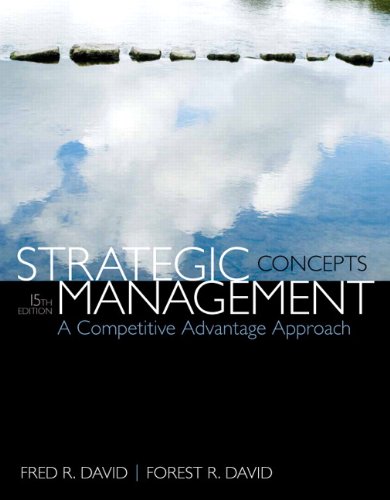
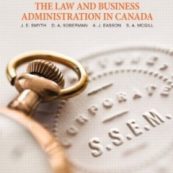
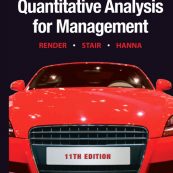
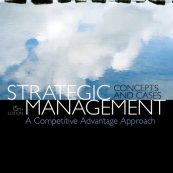
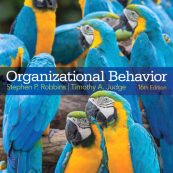
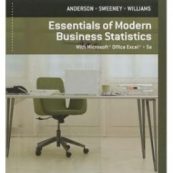
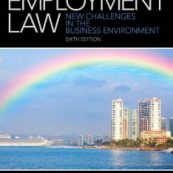

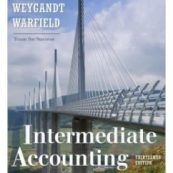
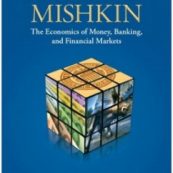
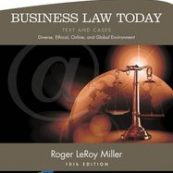
Reviews
There are no reviews yet.